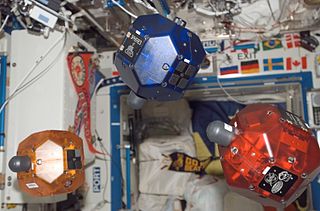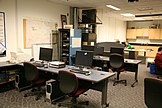
Iowa State University of Science and Technology is a public land-grant research university in Ames, Iowa. Founded in 1858 as the Iowa Agricultural College and Model Farm, Iowa State became one of the nation's first designated land-grant institutions when the Iowa Legislature accepted the provisions of the 1862 Morrill Act on September 11, 1862, making Iowa the first state in the nation to do so. On July 4, 1959, the college was officially renamed Iowa State University of Science and Technology.

The Ames Research Center (ARC), also known as NASA Ames, is a major NASA research center at Moffett Federal Airfield in California's Silicon Valley. It was founded in 1939 as the second National Advisory Committee for Aeronautics (NACA) laboratory. That agency was dissolved and its assets and personnel transferred to the newly created National Aeronautics and Space Administration (NASA) on October 1, 1958. NASA Ames is named in honor of Joseph Sweetman Ames, a physicist and one of the founding members of NACA. At last estimate NASA Ames had over US$3 billion in capital equipment, 2,300 research personnel and a US$860 million annual budget.

Karol Joseph "Bo" Bobko was an American aerospace engineer, U.S. Air Force officer, test pilot, and a USAF and NASA astronaut. Bobko was the first graduate of the U.S. Air Force Academy to travel in space and the first person to fly on a space shuttle on three different missions: STS-6, STS-51-D, STS-51-J.

The German Aerospace Center is the national center for aerospace, energy and transportation research of Germany, founded in 1969. It is headquartered in Cologne with 35 locations throughout Germany. The DLR is engaged in a wide range of research and development projects in national and international partnerships.

Project Echo was the first passive communications satellite experiment. Each of the two American spacecraft, launched in 1960 and 1964, were metalized balloon satellites acting as passive reflectors of microwave signals. Communication signals were transmitted from one location on Earth and bounced off the surface of the satellite to another Earth location.

High-altitude balloons or stratostats are usually uncrewed balloons typically filled with helium or hydrogen and released into the stratosphere, generally attaining between 18 and 37 km above sea level. In 2013, a balloon named BS 13-08 reached a record altitude of 53.7 km.

The ballute is a parachute-like braking device optimized for use at high altitudes and supersonic velocities.
JP Aerospace is an American company that aims to achieve affordable access to space. Their main activities include high-atmospheric lighter-than-air flights carrying cameras or miniature experiments called PongSats and minicubes. They are also engaged in an Airship to Orbit project.

The Space Sciences Laboratory (SSL) is an Organized Research Unit (ORU) of the University of California, Berkeley. Founded in 1959, the laboratory is located in the Berkeley Hills above the university campus. It has developed and continues to develop many projects in the space sciences, including the search for extraterrestrial life (SETI@home). The laboratory have built instruments to fly on more than 100 satellites and flown more than 150 balloons to "measure electric fields, auroral x-rays, hard x-rays and gamma rays, cosmic rays and the cosmic microwave background." The lab has also built and flown two dozen rockets to measure "auroral particles, UV emissions, and solar flare nuclei." It currently has projects categorized into planetary projects, geospace projects, solar and heliophysics projects, astrophysics and exoplanets projects, which are accompanied by a missions operations system, an engineering division and an information lab.
The Engineering Campus is the colloquial name for the portions of campus surrounding the Bardeen Quadrangle and the Beckman Quadrangle at the College of Engineering at the University of Illinois Urbana–Champaign. It is an area of approximately 30 square blocks, roughly bounded by Green Street on the south, Wright Street on the west, University Avenue on the north, and Gregory Street on the east.

The Synchronized Position Hold Engage and Reorient Experimental Satellite (SPHERES) are a series of miniaturized satellites developed by MIT's Space Systems Laboratory for NASA and US Military, to be used as a low-risk, extensible test bed for the development of metrology, formation flight, rendezvous, docking and autonomy algorithms that are critical for future space missions that use distributed spacecraft architecture, such as Terrestrial Planet Finder and Orbital Express.

Gregory Errol Chamitoff is a Canadian-born American engineer and former NASA astronaut. He has been to space twice, spending 6 months aboard the ISS across Expedition 17 and 18 in 2008, and another 15 days as part of STS-134 in 2011. STS-134 was the last of Space Shuttle Endeavour which delivered the Alpha Magnetic Spectrometer and completed the US Orbital Segment.

The Faculty of Aerospace Engineering at the Delft University of Technology in the Netherlands is the merger of two interrelated disciplines, aeronautical engineering and astronautical engineering. Aeronautical engineering works specifically with aircraft or aeronautics. Astronautical engineering works specifically with spacecraft or astronautics. At the Faculty of Aerospace Engineering, both of the fields are directly addressed along with expansion into fields such as wind energy.
The United States Naval Academy (USNA) Small Satellite Program (SSP) was founded in 1999 to actively pursue flight opportunities for miniature satellites designed, constructed, tested, and commanded or controlled by Midshipmen. The Naval Academy's aerospace laboratory facilities are some of the most advanced and extensive in the country. These facilities include structures labs, propulsion and rotor labs, simulation labs, wind tunnels with flow velocities ranging from subsonic to supersonic, computer labs, and the Satellite Ground Station. The SSP provides funds for component purchase and construction, travel in support of testing and integration, coordination with The US Department of Defense or National Aeronautics and Space Administration (NASA) laboratories or with universities for collaborative projects, and guides Midshipmen through the Department of Defense (DoD) Space Experiments Review Board (SERB) flight selection process.

The Research Institute for Advanced Computer Science (RIACS) was founded June 1, 1983 as a joint collaboration between the Universities Space Research Association (USRA) and the NASA Ames Research Center. The Institute was created to conduct basic and applied research in computer science, covering a broad range of research topics of interest to the aerospace community including supercomputing, computational fluid dynamics, computational chemistry, high performance networking, and artificial intelligence.

The Norman and Helen Asher Space Research Institute (ASRI) is a specialized institute dedicated to multidisciplinary scientific research at Technion - Israel Institute of Technology, in Haifa, Israel.

PhoneSat is an ongoing NASA project of building nanosatellites using unmodified consumer-grade off-the-shelf smartphones and Arduino platform and launching them into Low Earth Orbit. This project is part of NASA's Small Spacecraft Technology Program and was started in 2009 at NASA Ames Research Center.

The Mobile Rocket Base, abbreviated MORABA, is a department of the DLR Space Operations and Astronaut Training in Oberpfaffenhofen near Munich. Since the 1960s, the MORABA has performed scientific high altitude research missions with unmanned rockets and balloons, and has developed the required mechanical and electrical systems. Their operational areas include upper atmosphere research, microgravity research, astronomy, geophysics, materials science, as well as hypersonic research.

CAPSTONE is a lunar orbiter that is testing and verifying the calculated orbital stability planned for the Lunar Gateway space station. The spacecraft is a 12-unit CubeSat that is also testing a navigation system that is measuring its position relative to NASA's Lunar Reconnaissance Orbiter (LRO) without relying on ground stations. It was launched on 28 June 2022, arrived in lunar orbit on 14 November 2022, and was scheduled to orbit for six months. On 18 May 2023, it completed its primary mission to orbit in the near-rectilinear halo orbit for six months, but will stay on this orbit, continuing to perform experiments during an enhanced mission phase.
The Ann and H.J. Smead Department of Aerospace Engineering Sciences is a department within the College of Engineering & Applied Science at the University of Colorado Boulder, providing aerospace education and research. Housed primarily in the Aerospace Engineering Sciences building on the university's East Campus in Boulder, it awards baccalaureate, masters, and PhD degrees, as well as certificates, graduating approximately 225 students annually. The Ann and H.J. Smead Department of Aerospace Engineering Sciences is ranked 10th in the nation in both undergraduate and graduate aerospace engineering education among public universities by US News & World Report.

















